Enjoy instant access to a scalable system of proven practices and execution-ready tools. Built to launch strategic HR programs 5X faster!
✓ Enjoy platform access
✓ Create your HR roadmap
✓ View open content in library
✓ Access dozens of practices:
⤷ The HR Strategy program
⤷ Explainers and deep dives
⤷ Supplemental guides
⤷ Insight articles
⤷ Weekly best practices
⤷ And more!
100% Free. No credit card required.
This guide is part of a progression set comprised of Core, Advanced, and Emerging Leadership Development practices.
Leadership Development (LD) is the strategy and process of developing the key skills, capabilities, and styles top leaders need to drive organizational performance and culture successfully. It is a specialized learning and development function that initially focuses on the top levels of leadership and their unique development needs and requirements. LD involves the identification of differentiating capabilities or competencies that define excellence in leading others.
LD engages leaders in expanding their skillsets and capabilities over multiple years, ensuring they are prepared to respond positively and constructively to changing business and workforce challenges. At this level, leaders’ development needs are assessed at the aggregate level and refined through formal learning programs. These programs are designed to sharpen their strategic, business, operational, and relationship capabilities. LD also involves top leadership in defining the key characteristics and behaviors desired from leaders in the organization, which are then formalized in a standard leadership competency model. Leadership roles are segmented based on their impact, and role-holders are evaluated against the model for strengths and weaknesses.
Gaps between the idealized leader model and the current incumbents are identified, and key areas for development are defined and used as learning requirements for a common leadership development program. Program requirements become criteria for evaluating various vendors who can either develop tailored content and delivery or provide access to publicly available programs of their own creation.
Leadership development creates multiple benefits to the organization, most critically in preparing leaders to better envision and oversee corporate growth and success. It defines success and provides individuals with a common and standardized definition of the elements of leading successfully within a company’s unique culture. It can accelerate organizational change and growth by directing top leaders’ focus and behaviors towards common goals, reinforcing a company culture by clarifying what behaviors are most valued, helping maintain executive alignment around strategies, and encouraging best practice distribution.
Learning experiences promote constructive values regarding the management of people throughout an organization, with skill-building in leading and managing others for enhanced productivity, performance, and growth. Positive impacts on employee retention, engagement, and future leadership bench strength are designed outcomes for leaders and subordinates. A formalized program offers the benefit of a common language, commonly understood leadership behavior and performance standards, and shared education/development experiences that tend to create stronger bonds between leaders and leadership teams. The selection of the best-fit vendor can be conducted using structured criteria and templates that drive consistency and ease of comparison to business requirements, stated talent development goals, targeted learning objectives, and company cultural preferences.
Adopting the practices at this level provides clarity and guidance for the improvement and growth of skills required for success in leadership roles within the organization. A common competency model is developed that articulates the capabilities and associated behaviors that the most successful leaders leverage. It is designed based on a structured approach that reviews the differentiating characteristics and actions that define the reasons for success the top performers have exhibited and what will be needed in the future as the company evolves. It yields a formal assessment of all leaders in critical roles against those competencies and a budget for their development that is reviewed and approved by top leadership. A formal evaluation of all leaders yields a gap analysis that identifies the common development needs of the current leadership cohort. That analysis forms the basis for developing a standard “signature” leadership development program that will become the foundational training model for all leaders. The requirements for that program are identified, and suitable vendors are sought to either develop a program tailored for internal use or deliver a publicly available one for attendance by leadership team members. They provide a consistent learning experience for all participating leaders and a shared understanding of what outcomes and behaviors are expected and needed from leaders who seek to be successful in the organization over time and in business circumstances.
In the context of leadership development, competencies are commonly used as benchmarks for both superior performance and assessments for the development needs of current executives.
Leadership Development is an effort designed to prepare key leaders to better manage their organizations and role requirements. It typically involves an investment commensurate with their level.
Involves collecting data on each potential program participant from their direct superior and generating an aggregated "gap" analysis that reveals group-level weaknesses that need to be addressed by the selected development programs.
A signature program serves as the base learning event that all top leaders are required to attend. Such a program can range from a one week in-person offsite event to a multi-week series of online courses or even a multi-semester program at a university.

Enjoy instant access to a scalable system of proven practices and execution-ready tools. Built to launch strategic HR programs 5X faster!